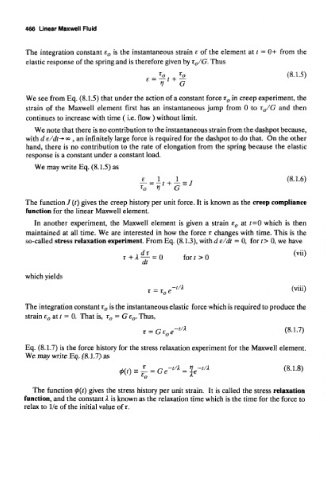Page 482 - Introduction to Continuum Mechanics
P. 482
466 Linear Maxwell Fluid
The integration constant e 0 is the instantaneous strain e of the element at t = 0+ from the
elastic response of the spring and is therefore given by r 0/G. Thus
We see from Eq. (8.1.5) that under the action of a constant force r 0 in creep experiment, the
strain of the Maxwell element first has an instantaneous jump from 0 to T 0/G and then
continues to increase with time (i.e. flow) without limit.
We note that there is no contribution to the instantaneous strain from the dashpot because,
with d e/dt-* oo , an infinitely large force is required for the dashpot to do that. On the other
hand, there is no contribution to the rate of elongation from the spring because the elastic
response is a constant under a constant load.
We may write Eq. (8.1.5) as
The function / (t) gives the creep history per unit force. It is known as the creep compliance
function for the linear Maxwell element.
In another experiment, the Maxwell element is given a strain e 0 at f=0 which is then
maintained at all time. We are interested in how the force r changes with time. This is the
so-called stress relaxation experiment. From Eq. (8.1.3), with d e/dt = 0, for t > 0, we have
which yields
The integration constant T O is the instantaneous elastic force which is required to produce the
strain e 0 at t = 0. That is, r 0 = G e 0. Thus,
Eq. (8.1.7) is the force history for the stress relaxation experiment for the Maxwell element.
We may write Eq. (8.1.7) as
The function <p(i) gives the stress history per unit strain. It is called the stress relaxation
function, and the constant A is known as the relaxation time which is the time for the force to
relax to 1/e of the initial value of r.

